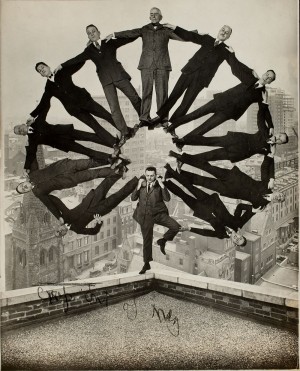‘Faking It’ at the Met: The Lie Behind Photographic ‘Truth’
Additionally, Dirigible Docked on Empire State Building, New York (1930), by an unknown American artist, is not only fascinating from a visual standpoint but from a historical one as well. In it, the zeppelin Los Angeles floats in midair, the nose of the ship anchored to a mooring mast atop the Empire State Building. However, since the building’s construction, no dirigible has ever docked at the mast. The print does capture the truth behind the spire, though, which was meant to serve as a disembarkation point for Europeans traveling to New York City. The aeronautical plan was ultimately impossible due to high winds, but the mast conveniently made the structure taller than the Chrysler Building, at the time the tallest skyscraper in the world. In this case, an inherently untruthful photograph aided to elucidate the history behind the iconic NYC landmark.
After Photoshop: Manipulated Photography in the Digital Age is a less-inspired sister exhibit centered on pictorial tweaking in the era of computers and microchips. Whereas Faking It drew from international sources, After Photoshop isn’t nearly as sprawling, consisting of around 25 works from the Met’s permanent collection. As such, it’s more of an addendum that puts a period at the end of Faking It’s sentence.
There are a few noteworthy pieces, however, such as German artist Beate Gütschow’s LS #3 (1999), a beautiful landscape whose apparent simplicity masks the painstaking amalgamation of over 100 images into a single composite, and Maria Marshall’s When I Grow Up I Want To Be A Cooker (1998), a short video clip depicting the artist’s two-year-old son smoking a cigarette and blowing smoke rings (the cigarette is fake and the smoke is the product of special-effects wizardry). In 110 Junction (2010), the digital creation of American photographer Matthew Porter, a 1970 Plymouth GTX hovers at an impossible height over a street in downtown Los Angeles, recalling chase scenes from 1960s and 1970s-era action movies. The print’s seeming simplicity betrays its complexity — Porter overlaid a die-cast model car into the L.A. streetscape to achieve his final result, and worked in his studio to recreate the late-afternoon lighting conditions of the background to seamlessly integrate the car into the shot. Furthermore, Belgian Filip Dujardin, a professional architectural photographer who since 2007 has been developing models of imaginary buildings, makes us reconsider the laws of physics and their relation to architectural structure in Untitled (2009). Dujardin, beginning in 3-D modeling program Google SketchUp, compiled hundreds of source images in Photoshop, adjusting colors, shadows and contrast to develop the model of an upside-down-L-shaped structure. The result is a building that appears far from structurally sound, yet remains remarkably intact, and forces viewers to rethink their notions of what is achievable in architectural design.
In today’s media-saturated environment, where photo alteration is as easy as logging on to Twitter, Facebook, Instagram, Pinterest, or any number of social media meccas and cropping a picture, uploading and downloading images occurs within a microsecond, we’ve become desensitized to post-Photoshop inventiveness. Sure, the possibilities appear interminable in the digital age, as demonstrated by the wide array of Photoshop-generated material in the Met’s showcase. But as the Faking It exposition conveys, photographers have wielded darkroom techniques to achieve a high degree of impressive, unique results. Electronic tinkering just doesn’t seem to have the flair, soul or, frankly, the artistic clout of manual manipulation in our world of digital inundation, making Faking It an all-around more enjoyable experience than After Photoshop.
Mia Fineman and the Met have pieced together a well-balanced, broad-yet-exhaustive exposé in Faking It, one that is visually exciting, pleasantly didactic and surprisingly comedic. For anyone remotely interested in photography and/or curious to learn about the deceptive process behind turning a raw image into an enhanced aesthetic product, these exhibits are bound to be a delight. American photographer Ansel Adams once said, “Not everybody trusts paintings but people believe photographs.” This inherent believability of the medium is what the Met turns on its head, leaving the impression that photographic truth doesn’t always equate to actual truth.
While the “Faking It” exhibit ended on January 27, 2013, “After Photoshop: Manipulated Photography in the Digital Age” can be viewed till May 27, 2013 at the Metropolitan Museum of Art, located at 1000 Fifth Avenue (at 82nd Street) New York, NY 10028. For more information, call 212-535-7710 or visit www.metmuseum.org.


